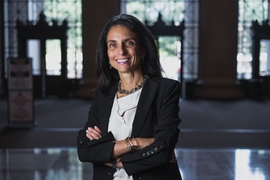George Nicholas Hatsopoulos, an MIT mechanical engineering senior lecturer emeritus who founded the Thermo Electron Corporation has passed away at the age of 91. Hatsopoulos '49, SM '50, ME '54, SCD '56 served as a life member emeritus of the MIT Corporation. In 1996, he received The John Fritz Medal which is often regarded as the highest honor in engineering.
Born in Athens, Greece, in 1927, Hatsopoulos demonstrated his ingenuity at a young age. Inspired by his many relatives who were engineers, he made an image projector using cellophane and light at the age of 6. He spent his early childhood enamored with Thomas Edison’s research and devoted much of his youth to studying Edison’s work.
Hatsopoulos was a junior in high school in 1942 when Nazis occupied Greece. His family was forced to house Nazi officers in their home. Undeterred by the risks, Hatsopoulos built radios using parts he found in the junkyard and would listen to broadcasts about the Allied Forces’ efforts — an activity outlawed by the Nazis who lived upstairs.
Shortly thereafter, he studied at the National Technical University of Athens. He then moved to the United States to continue studying at MIT. He received his bachelor’s degree, master of science degree, master of engineering degree, and doctorate of science degree in mechanical engineering at MIT. His doctoral thesis, entitled “The thermo-electron engine”, focused on thermodynamics and informed one of the biggest milestones of his career — the founding of Thermo Electron Corporation.
Upon graduating with his doctorate in 1956, Hatsopoulos joined the faculty in MIT’s Department of Mechanical Engineering. That same year, along with Peter Nomikos, he co-founded the Thermo Electron Corporation.
In a March 2016 interview for the MIT Infinite History Project, Hatsopoulos explained his philosophy when starting Thermo Electron. “My concept of a technology company is … have a group of outstanding people and then look around [and ask] what is an emerging need that society has?” he said. “See if you can find solutions to that and dedicate the company [to it], not only in any one business, but in the business of creating new businesses. That was my model.”
Hatsopoulos applied that philosophy after reading a New York Times article about heart disease in America. He was inspired to build a team within Thermo Electron devoted to developing the first artificial heart.
As CEO and Chairman of Thermo Electron, Hatsopoulos turned the company into a global leader in analytical and monitoring instruments. By the time he retired in 1999, Thermo Electron had over 24,000 employees in 23 countries and worked in industries ranging from medical devices and environmental systems to bomb detectors and biomass electric generation. In 2006, Thermo Electron merged with Fisher Scientific to form Thermo Fisher Scientific Inc., one of the world’s largest biotechnology companies.
While building Thermo Electron from the ground up, Hatsopoulos remained active within the MIT community. In 1962, he was named senior lecturer, a role he held until 1990. In the same interview with the MIT Infinite History Project, Hatsopoulos recalls a time when he was asked what he did for fun: “I said I teach, that’s my goal. I don’t like golf … but I like teaching, I have fun teaching.”
In addition to teaching, Hatsopoulos made major contributions to the field of thermodynamics throughout his career. In 1965, he published the seminal textbook, "Principles of General Thermodynamics," along with "Thermionic Energy Conversion Volume I" and "Thermionic Energy Conversion Volume II" in the 1970s. In 1976, he contributed to a pioneering formulation of a unified theory of mechanics and thermodynamics, which is viewed as a precursor of the emerging field of quantum thermodynamics.
Hatsopoulos served on a number of boards including the Federal Reserve Bank of Boston, the Governing Council of the National Academy of Engineering, and the National Bureau of Economic Research, just to name a few. He was a fellow of the National Academy of Engineering, the American Academy of Arts and Sciences, the American Institute of Aeronautics and Astronautics, the American Society of Mechanical Engineers, and the Institute of Electrical and Electronics Engineers.
Throughout his illustrious career in both academia and industry, Hatsopoulos was celebrated with numerous awards. In addition to The John Fritz Medal, he was named a commander of the Order of Honor in Greece and was named inventor of the year by the Boston Museum of Science in 1990.
Even after retiring from teaching in 1990, MIT remained an integral part of Hatsopoulos’ life. He was made a life member emeritus of the MIT Corporation. His daughter Marina received her master’s degree in mechanical engineering (MechE) at MIT in 1993, the same year she married his former student Walter Bornhorst, who received his PhD in mechanical engineering at MIT. Hatsopoulos’ granddaughter is a current MechE student.









